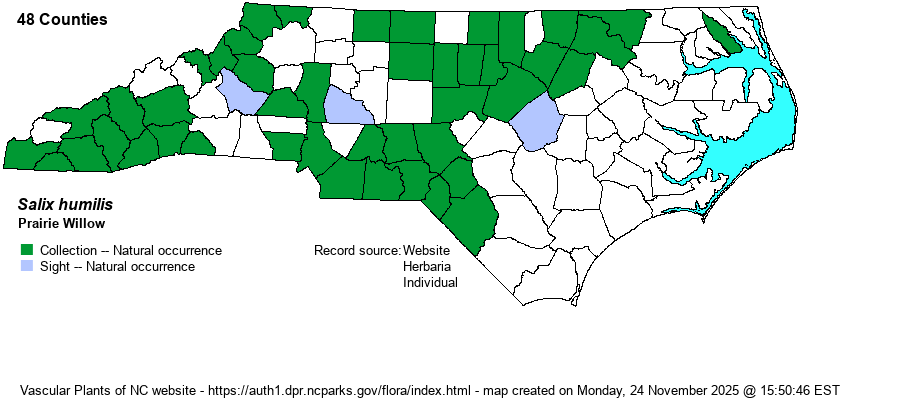| Section 6 » Order Salicales » Family Salicaceae |
Show/Hide Synonym
| taxonName | relationship | relatedTaxonName | relatedTaxonRefText | relComments |
|---|
|
|
|
|
| Salix humilis | < | Salix humilis | Radford, Ahles, and Bell (1968) | | | Salix humilis | < | Salix humilis | Godfrey and Wooten (1979, 1981) | (also see S. occidentalis) | | Salix humilis | = | Salix humilis var. humilis | Flora of North America (1993b, 1997, 2000, 2002a, 2002b, 2003a, 2004b, 2005, 2006a, 2006b, 2006c, 2007a, 2009, 2010) | | | Salix humilis | = | Salix humilis var. humilis | Kartesz (1999) | | | Salix humilis | = | Salix humilis var. humilis | | | | Salix humilis | = | Salix humilis var. humilis | | | | Salix humilis | = | Salix humilis var. humilis | Wofford (1989) | | | Salix humilis | = | Salix humilis var. humilis | Chen et al. (2010). Key adapted from Z and FNA. | | | Salix humilis | > | Salix humilis var. humilis | Fernald (1950) | | | Salix humilis | > | Salix humilis var. humilis | Flora of West Virginia | | | Salix humilis | > | Salix humilis var. hyporhysa | Fernald (1950) | | | Salix humilis | > | Salix humilis var. hyporhysa | Flora of West Virginia | | | Source: Weakley's Flora |
|
| Author | Marshall | |
| Distribution | Somewhat spottily distributed over the Piedmont, Mountains, and western/northern Coastal Plain (east to Pasquotank and Robeson counties), with oddly few records for the western Piedmont. Absent over most of the Coastal Plain. Note: the BONAP map includes both this species and the recently split S. occidentalis on the same map; thus, one cannot ascertain the actual range of either species from that map.
This species has a wide range from most of Canada south to northern FL and to northeastern TX. However, it is scarce in the Coastal Plain south of VA.
| |
| Abundance | Uncommon in the Mountains, and also in the northeastern quarter of the Piedmont. However, it is rare in the western and southeastern parts of the Piedmont, though likely occurring in all counties in the province. Very rare in the extreme northern and western Coastal Plain. | |
| Habitat | This species has a surprisingly wide array of mostly dry and sunny habitats, with none characteristic. It can be found along rocky or dry wooded borders, shrub or rocky balds, powerline clearings, and other upland and usually rocky sites. It can occasionally occur in damp ground. It favors higher pH soils. | |
| Phenology | Blooms and fruits from March to May. | |
| Identification | This is a medium-sized deciduous shrub, growing often in colonies, reaching an average height of 5-6 feet, rarely to 10 feet tall. It has elliptic to slightly oblanceolate leaves, with wavy margins that are not rolled or just barely rolled. Leaves are usually pale gray and woolly below and may average 3-4 inches long and about 2/3-inch wide, rarely to 1-inch wide. The very similar S. occidentalis is a smaller shrub with much smaller, narrower, and more wedge-shaped leaves, and it has essentially sessile leaves. Salix humilis leaves are distinctly petioled. In some ways, S. humilis looks a bit like a stunted or sapling oak -- a bit like a young Bluejack Oak (Q. incana) of the Coastal Plain. | |
| Taxonomic Comments | With the splitting out of S. occidentalis from S. humilis, this taxon now has no varieties, at least in NC.
The genus Salix is a very large and complex group of plants that vary from ground-hugging Arctic belly plants to huge trees. There are 113 species in North America alone, including introduced species. They are extremely important to browsing mammals -- rabbits, deer, elk, muskox, moose, many rodents -- and browsing birds like ptarmigan. Many birds use them to nest in. Here in NC we only have a small number of native species (5) and so do not appreciate the ecological importance of willows. We highly recommend reading the introductory pages of George Argus's FNA treatment (2010) and his excellent monograph on the willows of the southeastern U.S. (1986). The latter has drawings and descriptions of all southeastern U.S. taxa. Due to natural and horticultural hybridization, some plants will not key cleanly and you may have to compare your specimen with others verified by Argus. | |
| Other Common Name(s) | Upland Willow, Small Pussy Willow | |
| State Rank | S3 [S4] | |
| Global Rank | G5 | |
| State Status | | |
| US Status | | |
| USACE-agcp | FACU link |
| USACE-emp | FACU link |

